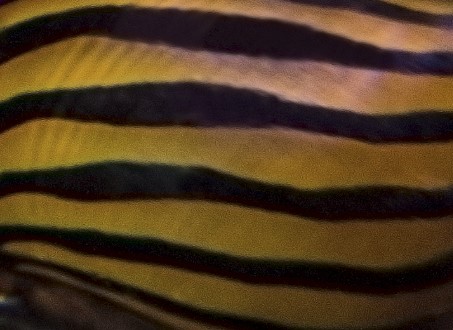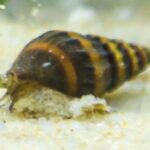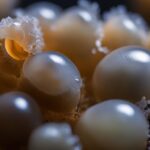Nerite snails are an extremely popular species for freshwater aquariums and come from the family of Neritidae, a large collection of over 200 varieties of snails. In this guide, we take a quick look at Nerite Snail types, unique features, and how to care form them. I personally have Nerite snails and enjoy the Zebra as my favourite.
They are found near the coastlines or tidal estuaries, but some types only live in freshwater or saltwater environments. Nerite snails especially thrive in brackish conditions and can reach up to 1-inch under optimal conditions.
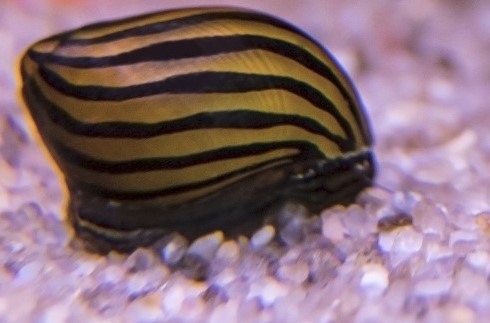
Plus, they are appreciated by hobbyists because they don’t require any extra added salt to their water like other species in their taxonomic family. This makes nerite snails a great choice for cleaning up your aquarium, whether it is filled with freshwater or brackish water.
Types of Nerite Snails
These delightful little creatures have a medium lifespan of 1-2 years and will happily begin munching away on algae as soon as they arrive at your home. They clean the surfaces of all unnecessary growth without becoming aggressive eaters and can help take care of any unwanted detritus that accumulates in your fish tank.
So if you want an easy-to-care-for addition to your clean up crew, look no further than these charming nerite snails!
Red Racer Nerite Snail
The Red Racer Nerite Snail (Vittina waigiensis) is an incredibly attractive and unique species of nerite snail. This particular variety is often sought out by aquarists wanting something truly special in their freshwater tanks. These snails have a vibrant red, orange and yellow shell, which together with their patterning resembles the racing stripes of a champion car, hence the name “Red Racer”. These snails can be found in all kinds of shapes and sizes as they are selectively bred to showcase all sorts of different shades and depths of color.
These Red Racer Nerite Snails may be relatively small but that does not diminish their impact on your aquarium environment – there are many excellent benefits to having these snails around! They eat algae and dead plant matter so detracting from the always annoying tasks of keeping tanks clean.
In addition, their grazing habits create a cleaner and healthier tank by eliminating filth that can settle on the surfaces preventing disease from spreading and helping to keep nitrates low. So if you’re looking for a reliable clean up crew or just some added color to your tank then consider getting yourself some Red Racer Nerite Snails!
Gold Racer Nerite Snail
Gold Racer Nerite Snail (Vittina waigiensis) is an incredibly eye-catching, rare species of nerite snail that can bring any tank to life. This unique species of snail has a bright orange shell, complimented by striking dark zebra stripes in a variety of patterns.
Not only do their patterns make them look stunning, they provide excellent camouflage in the wild. Unfortunately, because they are so rare they can be hard to find in pet stores; however, online aquarium supply stores have started selling them more frequently to meet consumer demand.
These small snails are easy to care for and will bring color and interest to any aquarium. Gold Race Nerite Snails need the same conditions that other nerites do: general hardness between 5-15 dKH, pH around 8 and some vegetative matter in the tank for them to munch on. Because they grow slowly and stay relatively small (1/2 inch – 1 inch long), they also won’t overtax your filter or create high levels of bioloads when housed with appropriate numbers or species of fish or other invertebrates.
Black Racer Nerite
The black racer nerite, also known as Neritina pulligera and dusky nerite snail, is a water-dwelling species of gastropod mollusk. These small snails prefer to inhabit brackish waters or still wetlands including marshes, ponds, streams and rivers. They have a dark brown shell with alternating pale and dark bands across each spiral. The coloration is used for camouflage and protection when moving about in the shallow waters that this species favors.
The black racer nerite is a hardy species that can survive in a variety of temperatures though slightly warmer climates are preferred for reproduction. This near threatened species feeds on diatoms and other small algae which helps keep its habitat clean and healthy by controlling the algae growth in its environment. In turn there are many beneficial creatures that rely on these snails including spiders who hunt them in their aquatic habitats as well as birds which provides food after they are eaten by other predators.
Tiger Nerite Snail
Tiger Nerite Snail (Neritina semiconica) is a species of small freshwater gastropod that can be found in shallow waterways throughout much of the world. The shell of this particular species has a light brown coloration with red bands and a smooth texture, giving it an eye-catching appearance. Reminiscent of tiger stripes or leopard spots, these snails also feature small black spots along their shells which further adds to their beautiful coloring.
Oftentimes found in heavily planted aquaria, the Tiger Nerite Snail is best suited for aquariums with soft to slightly hard water, as well as non-chlorinated and low salinity environment. They are omnivorous, so they feed on both tiny pieces of vegetation (plants) and bits of various types of algae. In turn, the Tiger Nerite Snail’s grazing habits can help keep your aquarium clean since they do not shy away from detritus or any other organic waste present in their habitat. As long as there is adequate access to food and suitable conditions the adults will grow up to 2 cm in size, with larger specimens being possible depending on the quality of care provided.
Midnight Black Nerite
The Midnight Black Nerite Snail is a fantastic addition to any aquarium. With their striking black shells and subtle color variations, these snails bring a unique appeal to both freshwater and saltwater tanks. They are hardy and easy to take care of, making them ideal for beginners and experienced aquarists alike. Plus, their hard shells act as a natural filter, helping keep your tank healthy by removing particles from the water.
Their generally black shell makes them perfect for dark substrates like sand or gravel; they really stand out against it, while other types of snails tend to blend in with lighter substrates. Although some snails can grow as large as an inch-and-a-half across, the Midnight Black Nerite Snail only reaches half an inch or less – meaning they don’t take up too much room in your tank. Finally, if your looking for something exotic but low maintenance, this nocturnal snail will surely add an element of interest to any tank!
Zebra Nerite Snail
Zebra Nerite Snail (Neritina natalensis) is a unique and attractive aquarium addition due to their eye-catching shell pattern. Featuring beautifully banded spirals, the shells of these snails are an unmistakable deep golden brown color that really pops against any aquarium backdrop. Not only do they look fantastic, but Nerite Snails are also some of the most popular and affordable invertebrates for sale in pet stores.
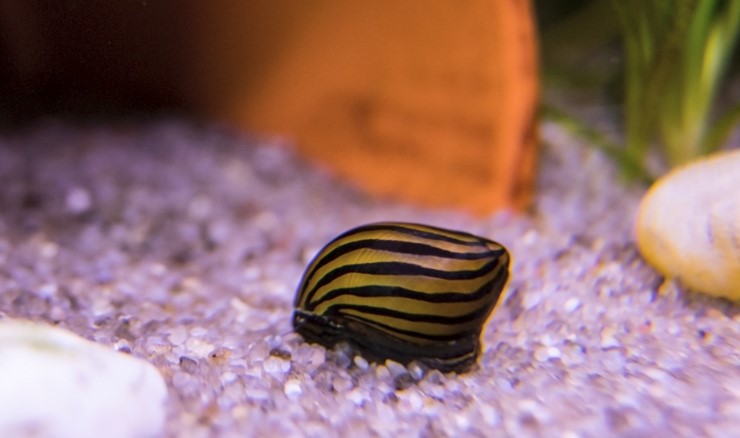
One of the best things about having Zebra Nerite Snails in your tank is that they are relatively low maintenance and easy to care for. These snails feed mainly on algae, which makes them ideal for keeping your tank clean by controlling algae growth. They don’t reproduce very rapidly, so they won’t overcrowd your tank either. Furthermore, these omnivorous creatures will also be happy to feed on sinking pellets or other prepared foods from time to time. As long as you provide them with plenty of oxygenated water and some nutritious food sources, these attractive little creatures should thrive in an aquarium environment without much extra effort.
Olive Nerite Snails
Olive Nerite Snails (Neritina reclivata) are a great addition to any freshwater tank. Not only do they look attractive and blend in well with the natural landscape, they help to keep your tank clean. Rather than nibbling on the plants in your tank, Olive Nerite Snails prefer to graze on algae growth and other biofilm. This helps to reduce some of the manual cleaning you would otherwise need to do.
Olive Nerite Snails are quite easy to care for, needing only basic maintenance such as fresh water and food combined with regular water tests and quality testing. These snails reproduce quickly, making them an ideal choice if algae is a problem in your tank. You can buy Olive Nerite Snail easily online from reliable sources or from local pet stores near you. They are also very affordable, so stocking up on these little helpers won’t break the bank.
Horned Nerite Snail (Horny Nerites)
They are commonly called ‘horny nerites’ because of the distinctive bumps or spurs on the outside of their shells. These bumps are known as nodules and are formed by a specialization in shell formation which gives these particular snail species its unique appearance.
This type of hardy snail often lay eggs just above and below the surface of any substrate they inhabit, such as wood or rocks in rivers or streams, which further makes them appealing aquarium companions given the right conditions. Horny nerites feed on algae and detritus, making them important cleaning agents when it comes to aquarium maintenance!
And Many more!
There may also be variations with different names such as Brown Zebra Snails, Tracked Nerite Snails, Ruby Nerite Snails, Plain Zebra Marble Nerite Snails, and more. It could simply be a loose naming system or it could be an indication of various species or varieties available.
How long to Nerite Snails Live
Most Nerite snails will live for 1-3 years in a home aquarium, however with proper care and maintenance, the lifespan of these snails can exceed five years in an aquarium environment.
The longevity of such snails depends largely on the conditions they are kept in and the level of care they receive. For example, they should be kept in clean water with consistent parameters to ensure optimal health and longevity.
An established filtration system must also be provided in order to maintain a free-flowing supply of oxygenated water. Besides these factors, proper feeding habits also play a key role in helping Nerite snails live as long as possible–be sure to provide them with suitable food sources such as algae wafers or blanched vegetables on a regular basis. With adequate levels of food and suitable living conditions, it is entirely possible for Nerite snails to reach the five-year mark before succumbing to old age or disease.
Food for Nerite Snails
they scavenge for bits of food, including any leftover fish food, decaying leaves, and especially algae. In order to ensure they get enough nutrition and don’t starve, offer them a variety of options such as algae wafers, blanched zucchini slices, and canned green beans. Nano Banquet Food Blocks are a great choice as well because in addition to calcium, plankton, and spirulina found in their diet, the blocks dissolve slowly over time adding more calcium to the tank water.
Aside from providing entertainment with their never-ending exploration of the tank walls and plants in search of tasty morsels to munch on all day long, nerite snails are also helpful when it comes to cleaning up excess algae growth. They specialize in devouring green spot algae (GSA), which can be tricky to remove from decorations or aquarium plants without harming them. No other snail species is better suited if your goal is preventing overcrowding by controlling and limiting algae growth.
Average Size of Nerite Snails
The tiny Smaragdia purpureomaculata is the smallest of the nerite snails with a maximum shell length of 0.1 inch (2.8 mm). A bit bigger is Vittina natalensis (spotted or zebra nerite), which has a maximum shell diameter of around 1 inch (2.5 cm). Puperita pupa, found in the Gulf of Mexico and Caribbean Sea, can grow up to 0.4 inch (1.1 cm). Finally, Neritodryas cornea (the horny nerite) stands out due to its bigger shell length that can reach up to 1.5 inches (4 cm).
How many Nerite Snails per Gallon
The rule of thumb is a maximum of two snails per ten gallons of water. This ensures that the beneficial bacteria levels stay optimal and that there isn’t an overabundance of detritus buildup in the aquarium. Young Nerites can double in size within a few weeks and need room to grow into adulthood, which means it’s important not to overcrowd them by adding too many at once or all at once. As with any hobbyist’s new additions, it pays off to research adequately beforehand – this ensures you have happy and healthy creatures living happily in their aquatic home!
Conclusions
Nerite snails are fascinating additions to any home aquarium, providing hours of entertainment and useful cleaning services. Although they differ in many shapes, styles and sizes , all Nerite snails will thrive when provided with suitable living conditions and adequate nutrition. As long as you keep an eye on their food intake, water parameters and follow the two-per-ten gallon rule for stocking density, these snails can live for up to five years in your tank!
I also cover Nerite snails with Shrimp and Nerite Snails with Betta in other articles if you are considering adding to your tanks.

